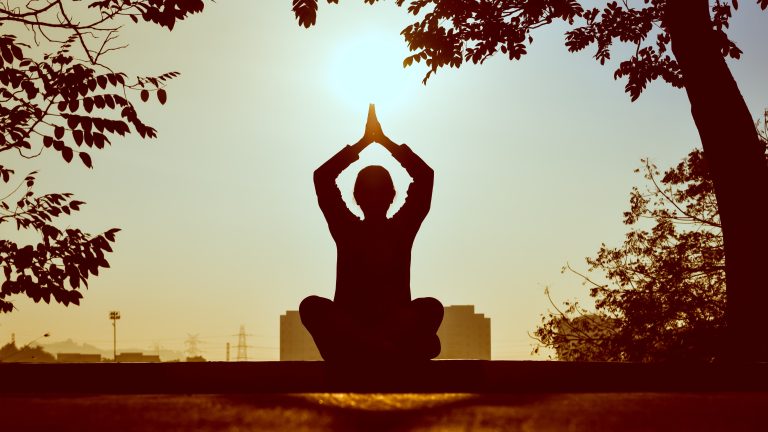Effective in enhancing one’s spiritual, mental and physical well-being — meditation originates from the Latin word meditatum, meaning, “to ponder”, and involves gaining control over your thoughts and emotions.
It has been an instrumental practice in ancient India and continues to grow relevant globally, owing to our busy schedules and demanding lives. And while it may belong to several traditions and cultures, the technique doesn’t belong to any one practice or faith. This has led to people everywhere relying on meditation to bring about a sense of peace, calm and inner harmony.
Meditation can help control stress, worry, negative thoughts and emotions and also help improve concentration, self-awareness and emotional regulation. Some types of meditation even focus on improving the quality of life, while others provide a more spiritual experience.
Download the app today!
As you might have guessed, there are several different types of Buddhist meditations which you can use to calm your mind and clear your thoughts. Each has its benefits and purpose. The goal is to find a technique or theme that suits your needs and you. Here is a list of 9 meditation types you can explore as you begin your journey toward a more peaceful mind.
Types Of Meditation
-
Mindfulness Meditation
One of the most popular forms of meditation, mindfulness meditation involves being fully aware and present in the moment. Awareness of where you are, what you’re doing and what you’re thinking — mindfulness meditation requires focus and concentration. Although, it’s important to note that you are not required to judge or become involved with your thoughts and emotions. Simply acknowledge and observe as they pass through your mind. The best part about this practice is that you can do it anywhere and at any time – when sitting in a park, commuting to work or during chores too!
-
Loving Kindness Meditation
Wish to strengthen feelings of love, compassion and kindness towards yourself and others? Then this meditation style is for you. Get in a comfortable, relaxed position and slowly repeat words and phrases that evoke positive energy and goodwill. Some examples of love and kindness messages that you could say are “May I be happy” or “May I be safe”. After you have directed these positive feelings to yourself, picture a family member, friend or acquaintance and repeat the words replacing “I” with “you”. This meditation style is helpful for those who hold feelings of anger and resentment and wish to let go of these negative emotions.
-
Visualization Meditation
This practice enhances feelings of relaxation, calm and peace by asking you to imagine positive images, scenes and figures. It encourages you to vividly picture a scene and use all five senses to add as much detail as possible. You may even imagine a person – a family member, an old friend, an honoured figure – or picture yourself achieving a goal. Visualising something specific not only helps drive focus but also offers motivation and helps boost the mood.
-
Yoga Meditation
Yoga is one of the oldest forms of meditation. Like meditation, yoga has multiple styles and forms that involve postures and breathing exercises to help calm the mind and promote flexibility. By eliminating distractions around you, yoga encourages one to focus, stay in the moment and work on your body balance. One of the many yoga poses, the Shavasana or savasana pose is for those seeking to relax their mind and body and relieve all tension. It is typically practised at the end of a yoga session and involves lying on the ground, facing up with your arms and legs comfortably spread and eyes closed. The purpose is to release all stress and get into a peaceful, meditative state.
-
Transcendental Meditation
Performed by being seated with your eyes closed for 20 minutes daily, this type of meditation involves chanting a word, phrase or sound to invoke a feeling of relaxation and calmness. The goal is to transcend your current state of being by taking slow deep breaths and repeating a mantra. This meditation is best indulged in with a qualified transcendental meditation teacher who can help you initiate the technique and create a mantra that applies to you. You can practise this meditation twice a day – once in the morning and once in the afternoon or early evening – for the best results.

Meet your Happiness Goals on Happily
Our Relevant Products
Feel Calm
Feel Motivated
Mindful Relationships
Personal Growth
Brtter Sleep
Slowing Down
and many more...
-
Spiritual Meditation
Used in many religions and spiritual faiths, this is a diverse form of meditation that aims to connect with a higher force, a higher being. This meditation style is perfect for those who wish to achieve spiritual growth and link with a power greater than the individual self. It entails sitting in silence, focusing on your breath and repeating affirmations based on spirituality, faith and trust in the Creator. You may practise this meditation at home or in a place of worship.
-
Progressive Meditation
Intended to sync the body and mind, progressive meditation, also popularly known as body scan meditation, helps reduce tension in the body. To practise this meditation technique, you must start by doing a mental scan of your body beginning from the top of your head and moving down to your toes or vice versa. Try to feel all sensations (discomfort, pain, aches) in your body as you mentally scan through each body part. It helps relieve stress, is a great way to unwind before bedtime and, believe it or not, is also helpful to those who suffer from chronic pain.
-
Meditation Stories
A fascinating form of visualization meditation, meditation stories use storytelling to help you relax and focus your mind. This meditation type typically involves listening to a narrator who tells a story intended to help you relax, let go of tension, and find peace and tranquillity inside yourself. These stories could be based on specific themes such as nature, spiritual journeys, or self-discovery to help induce deep relaxation by asking you to imagine the story coming to life. The goal is to help you escape the busyness of your daily life and create a sense of peace and calmness within yourself.
-
Sound Meditation
The healing power of sound is said to have a powerful and effective influence on the brain, helping to soothe the mind and calm the nervous system. Sound meditation harnesses this healing power to induce deep relaxation and inner stillness. It allows you to release physical and mental tension and access deeper states of consciousness. While indulging in this meditation style, one may listen to different sounds, such as singing bowls, gongs, chimes, chants, music and ASMR (whispers, tapping, crinkling and other sounds) to help relax, reduce stress, sleep soundly, and generally feel better.
There are several different meditation styles, but with the above list, we have tried to include some of the most common meditation techniques used to relieve stress, anxiety and tension. While each practice has its style, the idea behind them is similar: to tune in to your mind and heart to calm down and focus.
All in all, it’s helpful to know the different types of meditation available. Having this knowledge not only helps you understand how to focus when you meditate but also enables you to start your search for the right type that will suit your needs. Quite possibly, with so many varieties and techniques, there is an option that suits just about every experience level and preference — and it may not be such a bad idea to try out a few different techniques over time to see which one works best for you.
With that, we wish you good luck and happy meditating!






